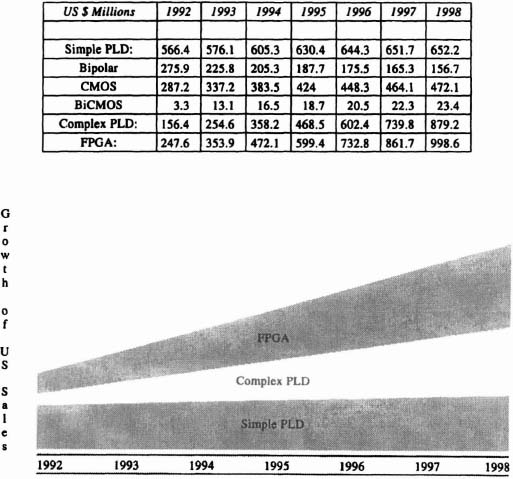7.3 FPGA MARKET AND START-UP COMPANIES
The FPGA market has progressed through several evolutions, beginning with logic replacement and rapid prototyping to an emerging technology allowing dynamic reconfiguration. The market has consistently grown due the advantages of the device and the continuing development of new applications. In 1990 worldwide sales of FPGAs were $108 million, expanding to $187 million in 1991 [Willett92]. By 1992 U.S. sales of FPGAs reached $247.6 million, representing a 56.7% growth rate for the FPGA within the U.S. programmable logic market. According to In-Stat, Inc., the U.S. FPGA market grew 42.9% from 1992 to 1993. In-Stat, Inc., has projected the U.S. FPGA market will grow from $353.9 million in 1993 to $998.6 million by 1998; a compounded annual growth rate of 23.1% [Rohl94] (see Figures 7–1 and 7–2).
The FPGA enabled companies in telecommunications, cable, medical device development, among others, to move products to market more efficiently. There are distinct phases of application development, as designers and managers see the potential of a new approach, ranging from initial, hesitant steps to major paradigm shifts, that is, exploiting the new device for its unique capabilities.

Figure 7–1. Programmable logic market, 5-year forecast as of April 1994. Derived from data provided by In-Stat, Inc. †
7.3.1 Rapid Prototyping
Due to the user-programmable ...
Get Field-Programmable Gate Arrays: Reconfigurable Logic for Rapid Prototyping and Implementation of Digital Systems now with the O’Reilly learning platform.
O’Reilly members experience books, live events, courses curated by job role, and more from O’Reilly and nearly 200 top publishers.

